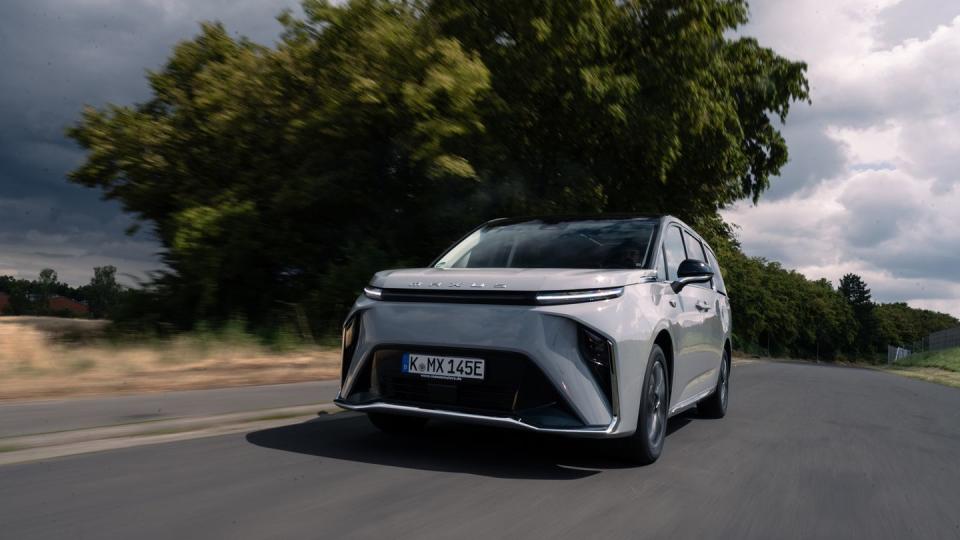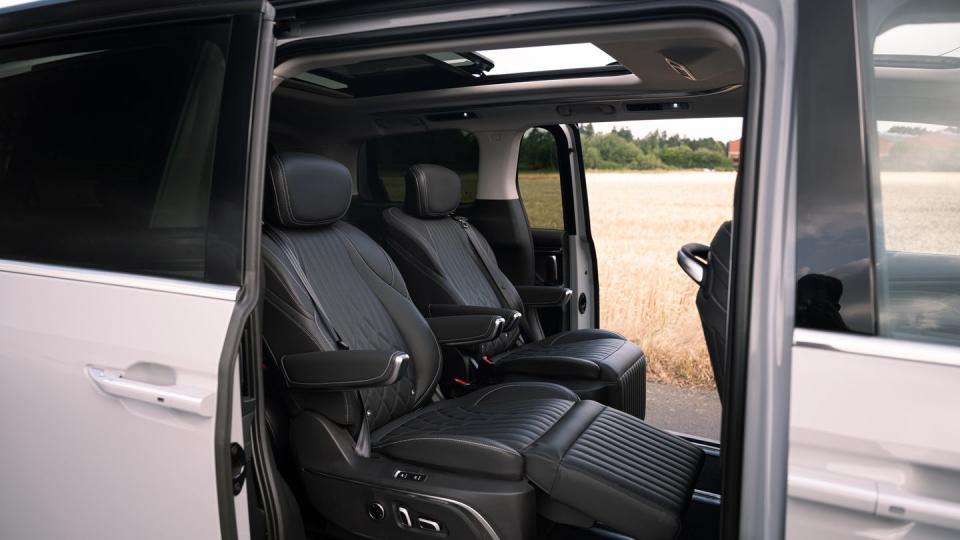SAIC Maxus MIFA 9 Is a Unique Take on EV Luxury

Hindsight is always 20/20, but looking back we can see that the minivan was an obvious step for the American auto industry to take in the early 1980s. The combination of larger families and longer journeys to the nation's growing number of destination theme parks gave the impetus to create something better able to carry bigger quantities of human cargo than that previous favorite clan-hauler—a station wagon with cushions in the trunk. Vehicles like the Dodge Caravan, Chevrolet Astro, and—in very much last place—Ford Windstar responded to this need. The same held true in other parts of the world, like France, where the original Renault Espace was created around similar grande famille priorities.
Now China has reached the same epoch of automotive evolution—but is doing so electrically. The three-row Maxus MIFA 9 is an EV minivan that combines serious internal space, impressive equipment levels, and a front-end design that immediately makes us think of Star Wars bounty hunter Boba Fett. Having driven it in Germany, where it recently went on sale, we can report it is as striking in three dimensions as it is in two.
Maxus is a commercial brand belonging to SAIC Motor, formerly known as Shanghai Automotive Industry Corporation, China's biggest automaker. The Maxus name comes from a long-defunct U.K. vanmaker, which SAIC acquired the rights to some time ago. MIFA is apparently an acronym: Maximum Intelligent Friendly Artistic. The MIFA 9 sits on the same platform as a gasoline-powered model called the Maxus G90, but the EV is distinguished by grander design, more equipment, and a heftier price tag. The original MIFA concept car was shown at the Shanghai auto show in 2021. The production version we drove featured a single 241-hp motor powering the front wheels and fed by a battery pack with a claimed 90-kWh capacity. It has an estimated range of around 275 miles under Europe's flattering WLTP test cycle.
Although China in 2016 moved beyond its single-child policy—which had restricted parents to just one kid—the legal limit subsequently was only raised to two. So, demand for vehicles like the MIFA 9 isn't coming from the need to haul big families but rather the need to transport VIPs in space and style.

That priority is clear in the differing missions assigned for each row of seating. Up front the confines are comfortable, well finished, and short on ergonomic fuss—clearly designed for professional drivers. There is a touch-sensitive control panel for climate-control functions, but almost everything else is controlled by the 12.3-inch central touchscreen. The middle row, behind electrically operated doors, is where the luxury resides on the top-spec Premium version we drove, with two power-adjustable airline-style seats complete with motorized footrests. This is where plutocrats get pampered. But behind them things turn cheap, as the third row is a bench with limited legroom and an upright backrest, a place to put kids or junior staff. If it were a ship then the respective demarcation by row would be bridge, first class, steerage.
Unsurprisingly, the driving experience is utterly bland. The MIFA 9 has been designed for ease of operation and a level of smoothness to allow passengers to snooze undisturbed. Gentle pressure on the accelerator produces almost seamless starts, although pushing harder tended to create a modest amount of wheelspin as the front tires battle to get about 5500 pounds of van moving. The Maxus can be stopped just as unobtrusively, thanks to its ability to seamlessly blend regenerative and friction braking. But the steering is light and completely lacking in discernible feedback. Bizarrely there are separate switchable Sport modes for both the accelerator and steering maps—it is hard to think of any car that needs them less—and in the case of the steering all this adds is extra weight.
But the MIFA 9 has some fine qualities too. Its soft suspension gives it a pliant ride, but it isn't lacking in chassis discipline over bumps as speeds start to rise. Even moderately keen cornering produces body roll and would bring doubtless admonition from the rear seats. But the Maxus tracks straight and feels very stable at highway speeds, and noise insulation is good for something with such a large frontal area. While acceleration is leisurely by EV standards—an official 62-mph time of 9.2 seconds—the Maxus is happy to cruise at an indicated 80 mph in serene comfort. That's presuming the driver has taken the time to deactivate the over-sensitive lane-keeping assistant and its loud warning chimes. Top speed is electronically limited to 112 mph, although achieving that would likely kill the cruising range. We didn't.
Switching to the middle row proves the MIFA 9 is a fine vehicle in which to be chauffeured. The seats are comfortable and offer sufficient adjustment to allow a reclining angle that leaves an occupant looking through the glass moonroof. There is also a massage function, plus heating and active cooling. Each seat has twin USB chargers, plus a pair of pop-out cupholders, and between the front seats is a deployable domestic socket for higher-voltage accessories.
Ultimate legroom in the second row is limited unless the front seats are motored forward, and reclining fully will obviously reduce the already limited space for anyone in the third row. Nor can the rearmost seats be fully folded to increase luggage space; the backs can be collapsed, but the base remains in place because of the battery location. Yet while the MIFA 9 we drove in Germany felt plenty grand, top-spec Chinese-market cars seem to be considerably posher with twin high-definition screens built into the dashboard and six seats arranged in pairs with even plusher thrones in the second and third rows, along with fold-out tables and individual touchscreen controls.

No part of the MIFA 9 feels insubstantial or cheap, with that reality being reflected by the price tag. In Germany the entry-level version, with manual rather than electrically adjustable second-row seats, costs 57,974 euros before tax—$63,400 at current exchange rates. The Luxury version brings power rear seats for 63,854 euros ($69,800), and the top-spec Premium adds the motorized leg rests plus various other spec enhancements for 67,739 euros ($74,100). That puts it pretty much on par with plusher versions of the electric long-wheelbase Mercedes-Benz EQV, the most obvious alternative in this part of the market.
While it is likely that most German shoppers will prefer to buy their EV minivans from familiar brands, the MIFA 9 illustrates that the Chinese industry can produce something that, while not a traditional luxury car, is a genuinely luxurious vehicle.
You Might Also Like

 Yahoo Autos
Yahoo Autos 